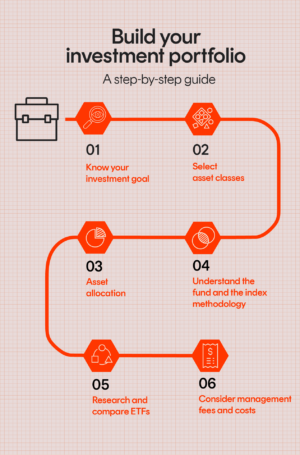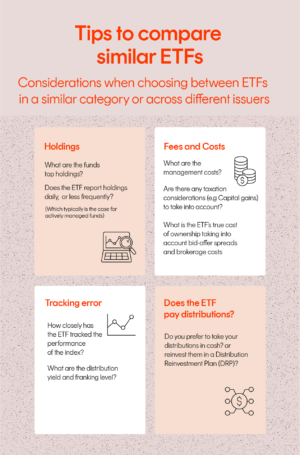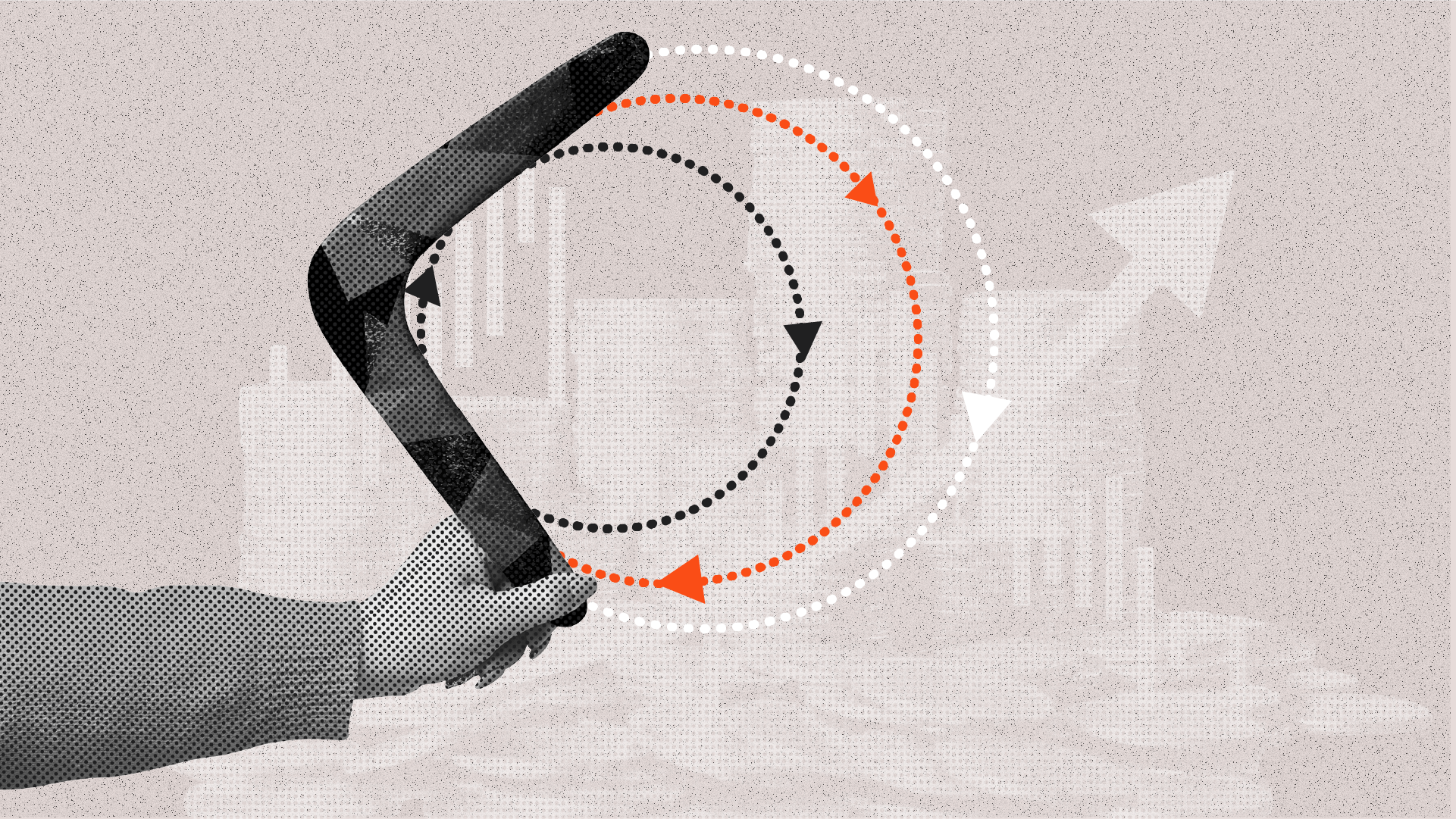
If you’re looking for a simple way to construct a balanced investment portfolio, ETFs may be the answer.
Most investors are faced with the same question when beginning their investment journey – that is, exactly what to invest in to build an investment portfolio suitable for their goals.
With the expansive ETF range available on the ASX offering diversified exposure to equities, fixed income and commodities, both in Australia and internationally, entire portfolios can be built exclusively with ETFs.

Summary
- Trying to choose individual stocks can be overwhelming with endless opportunities (and risks), with the added pressure to pick the “winners”
- ETFs can not only help to simplify the decision-making process by alleviating the potential pain points of picking individual investments, but are an easily accessible and low-cost way to build a complete investment portfolio
- One approach to building a balanced investment portfolio is to choose a small number of ETFs spanning across various asset classes
- These ETFs can form the long-term foundation of your portfolio. For example, providing exposure to Australian shares, global shares and fixed income or commodities. You can add to these over time.
Key factors to guide your investment portfolio build
Investment goal
Are you looking for capital preservation, growth, regular income, or a combination of the three?
First things first, investors should consider their investment goal. At this stage, it’s helpful to think about your circumstances, including your objectives, time horizon and risk tolerance.
You can choose your asset classes and decide on asset allocation next, based on your investment strategy, by considering the risk/return factors associated with each asset class.
For example, an investor who has time on their sidemay build their investment portfolio with more exposure to growth assets than defensive assets, because they can better absorb the volatility that can be associated with growth stocks.
However, if you’re investing later in life, you may have a lower risk tolerance, and instead might prefer a more balanced combination of both defensive and growth assets.
Asset class
When building a balanced investment portfolio, investors generally tend to seek exposure to the five main asset classes – equities, fixed income, property, commodities and cash.
Equities for growth
Investors looking for growth may invest more of their portfolio in equities (or shares) via Australian share ETFs and international share ETFs.
Cash and fixed income for defensive
Investors seeking regular income or exposure to defensive assets for their portfolio may turn to cash and fixed income, such as bonds and hybrids, as these tend to have a lower risk profile.
Commodities or alternative assets for diversification
Commodities, such as gold or oil, can form part of a balanced portfolio, offering potential diversification benefits given the historically low correlation of commodities to the other major asset classes.
By investing in commodity ETFs, you don’t need to directly invest in complex financial instruments such as futures, and there’s also no requirement to take physical delivery of any commodities.
Asset allocation – bringing it all together
After deciding on the combination of asset classes to suit your investment goals, the next decision is to decide the allocation to each asset to build your portfolio.
Traditional asset allocation strategies seek to mitigate overall portfolio volatility by combining asset classes with low correlations to each other – that is, asset classes that don’t tend to move in the same direction at the same time.
In a well-diversified portfolio, if one portion of the portfolio performs poorly over a certain period, this could be offset by the better performance of another part of your portfolio, so you are less likely to suffer a big loss across your entire portfolio.
Diversification within asset classes is also important to factor in. For example, within equities, you may consider diversifying by investing in share markets in different regions and different industry sectors.
Betashares also offers a range of multi-asset, all-in-one diversified ETFs, which take care of the asset allocation decisions for you, with passively blended multi-asset portfolios available across a range of different risk profiles.
Core/satellite: A portfolio construction strategy

The core/satellite investment strategy is one approach to building a portfolio.
The core or the foundation of your portfolio typically contains a number of investments that give you broad exposure across a range of asset classes.
Your core could also include:
- a broad-based Australian equities and/or global equities fund
- a broad market ethical fund
- a broad-based fixed income fund.
The satellite component of your portfolio comprises investments you may choose to generate extra returns.
This could include investments to take advantage of short-term opportunities, or more focused exposures than the broad exposures that make up the core of your portfolio.
For example, you might invest in a fund offering a particular thematic exposure, such as HACK Global Cybersecurity ETF or ERTH Climate Change Innovation ETF .
Tips to research and compare different ETFs

Once you’ve decided on your approach to portfolio construction based on your asset allocation, it’s time to select your individual ETFs. Here are some tips to research and compare different funds.
Understand the fund and the index which the ETF aims to track (if any)
Two ETFs that focus on the same sector and have similar names can have completely different underlying holdings if the indices they track are constructed differently.
Look under the hood of each ETF to see what the fund owns and how the holdings are weighted based on the index methodology.
Some key considerations:
- What is the fund’s investment objective?
- Is it a passive or actively managed strategy?
- If the ETF aims to track an index, what is the index methodology i.e. weighted by market capitalisation, fundamentally-weighted, equal-weighted, or rules-based?
Consider any overlap in holdings, countries and sectors for diversification
An overlap can occur when an investor holds multiple ETFs that each invest in the same or similar securities. This is why it’s important to understand the index methodology. To analyse any crossover, compare the top holdings of various ETFs you’re interested in.
It’s also important to consider the countries, regions or sectors an ETF offers exposure to, and the weightings of the ETF’s holdings regarding these factors, to avoid concentrated exposure in your portfolio.
For example, due to the current composition of the top 200 companies on the ASX by market capitalisation, a fund that aims to track the performance of those companies will be heavily weighted towards the financial and resources sectors, compared to, for example, a fund that seeks to track the Nasdaq 100 Index, which has a significant allocation to technology.
Size can matter too. Another way to ensure diversification is to balance your investment in companies of different sizes, or market capitalisation.
Understand the fees and costs
Consider what the total fees and costs are to purchase, maintain, and sell your unit holding in the ETF, and understand whether there are any taxation considerations (e.g. capital gains) that need to be taken into account.
Learn more...
To learn more about ETFs and how they could to help you achieve your investment goals, visit our Betashares Education Centre.
Buy ETFs effortlessly with Betashares Direct
Betashares Direct is the new investing platform designed to help you build wealth, your way. Users have access to professionally constructed pre-built portfolios or custom portfolios, through Betashares Direct.

Written by
Holly Morgan
Content Manager


